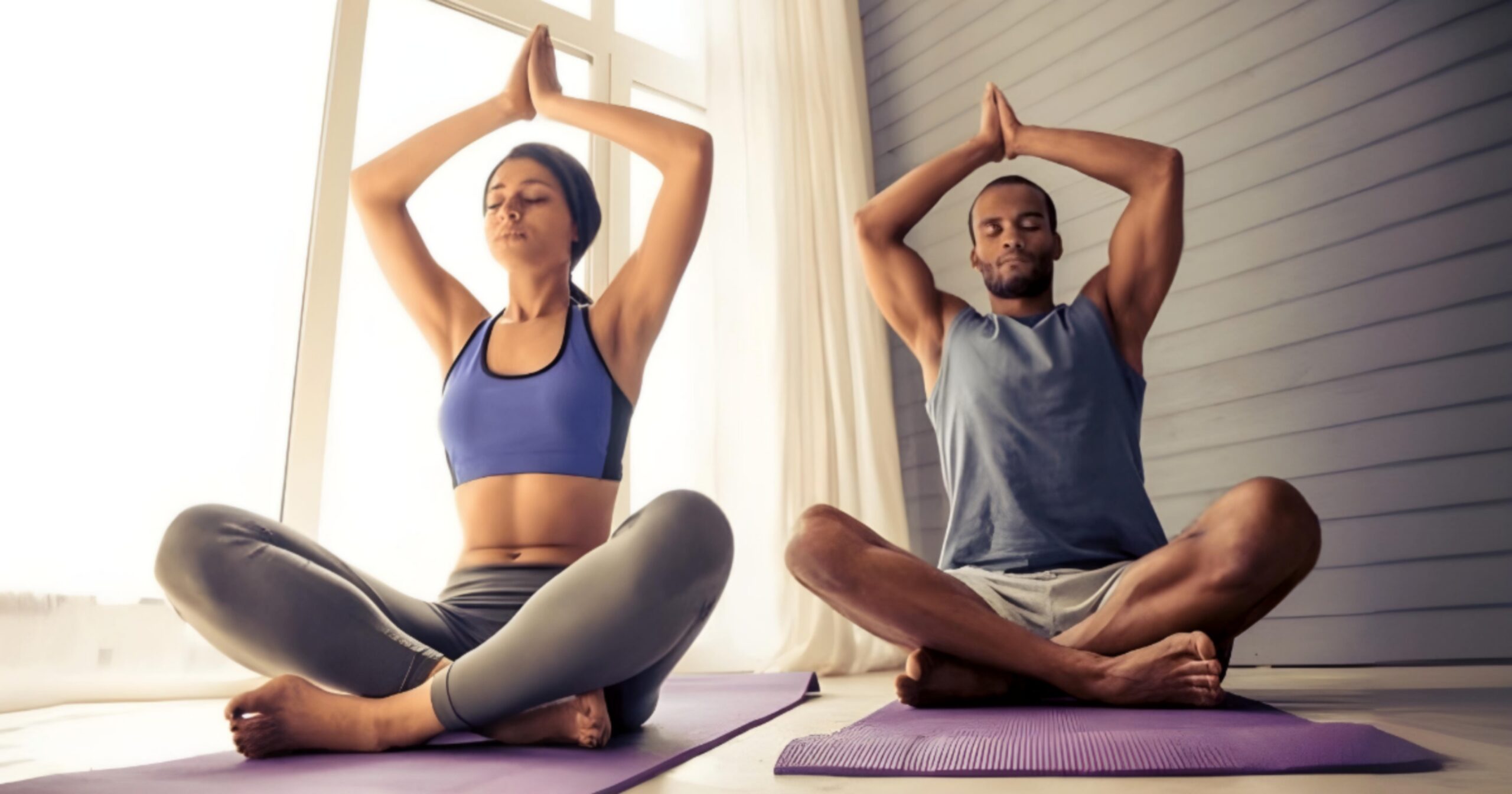Listen to this article:
Key Takeaway
Sitting cross-legged, or in Sukhasana, is versatile in yoga and meditation and known for its numerous benefits, including improved posture and enhanced focus. Learn how to navigate discomfort by practicing body awareness, using props, and exploring alternate positions.
| CROSS-LEGGED SITTING | |
|---|---|
| Alternate name: | Sukhasana |
| Difficulty level: | Beginner |
| Pose category: | Seated |
| Muscle groups: | Hip flexors (hips) Gluteal muscles (buttocks) Adductors (inner thighs) Hamstrings (back of the thighs) Erector spinae (back) Abdominals (core) |
| Physical benefits: | Improved posture, easier breathing. |
| Therapeutic applications: | Improved posture, enhanced focus |
| Preparatory poses: | Accomplished Pose (Siddhasana) Staff Pose (Dandasana) |
| Counterposes that follow well: | Thunderbolt Pose (Vajrasana) Staff Pose (Dandasana) |
| Chakras activated: | Root Chakra (Muladhara) |
| Most helpful prop: |  Blanket or cushion: Under hips, improves posture, reduces strain. See latest price |
When teaching yoga, I often give the cue, “Come to a comfortable seat,” in preparation for breathwork or meditation. Usually, I expect my students will settle into a seated, cross-legged position. But what if sitting this way isn’t comfortable?
In yoga, we call this cross-legged sitting position “Easy Pose” or “Sukhasana.” For many practitioners, it produces a grounded, calm feeling, making it an excellent posture for meditation. But if you experience discomfort while sitting cross-legged, you’ll have difficulty releasing tension and calming your mind during meditation.
Fortunately, there are practical solutions to alleviate potential discomfort associated with sitting cross-legged. From using props to adjusting your position, this article provides all the information you need to maintain comfort while sitting in Sukhasana.
Contents
- 1 Uses of the Cross-Legged Sitting Position
- 2 Benefits of Easy Pose in Yoga and Meditation
- 3 Contraindications and Common Concerns with Cross-Legged Sitting
- 4 Tips and Alignment Cues for Maintaining a Comfortable Seat
- 5 Prop Use for Comfort in Cross-Legged Pose
- 6 Alternatives to Crossed Legs Position in Yoga
- 7 Advice for Physically Adapting to Cross-Legged Sitting
- 8 Closing Thoughts
- 9 Frequently Asked Questions
- 9.1 What are some common uses of the cross-legged position?
- 9.2 What are some common mistakes people make when sitting cross-legged?
- 9.3 How can I ease discomfort when sitting in a cross-legged position?
- 9.4 Are there alternatives to sitting with crossed legs in yoga if it causes discomfort?
- 9.5 Was this helpful?
Uses of the Cross-Legged Sitting Position
Exploring ways to make sitting cross-legged more comfortable is crucial for many reasons. We use this position all the time — not just in practicing yoga but in everyday activities.
Yoga Practices
Sitting in a cross-legged pose is a staple in yoga. You’ll likely encounter this position during seated stretches, transitioning between positions, or as a base for meditation, chanting, and pranayama breathing exercises.
In my yoga practice and teaching, I find the cross-legged position essential. I regularly use this posture at the beginning of my sessions to center my attention in preparation for movement. Even when I’m not doing an entire yoga class, I sometimes sit in Sukhasana to stretch my neck and shoulders.
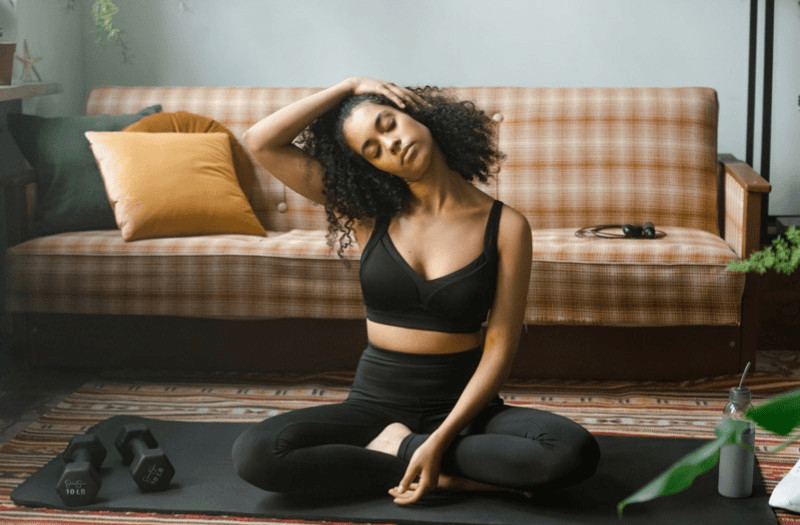
Everyday Life
The cross-legged sitting position isn’t just limited to yoga; it’s helpful in daily life, too. Whether you’re sitting on the floor playing with children, participating in a picnic, or needing to sit without chairs around, mastering this pose can keep you comfortable.
Benefits of Easy Pose in Yoga and Meditation
When you can sit in a cross-legged position with ease, you can access many benefits.
- Mental clarity: When we sit in this position regularly during meditation, it helps clear our thoughts. The body becomes still, allowing the mind to focus.
- Postural awareness: This simple seated position engages and strengthens our back muscles. Over time, this can significantly improve how we carry ourselves.
- Easier breathing: Using proper alignment in Sukhasana, your lungs have more room to expand. The position naturally encourages deep, easy breaths, which help reduce stress levels.
Contraindications and Common Concerns with Cross-Legged Sitting
Sitting cross-legged comes naturally to us as children; however, as adults, we tend to lose flexibility and become more stiff in our joints. Here are some of the most common complaints from students who experience discomfort in Easy Pose.
- Joint Pain: Discomfort or pain in the knees, hips, and ankles.
- Numbness and Reduced Circulation: Pressure applied to the legs while sitting in this position can compress blood vessels, decreasing circulation and creating that annoying “pins and needles” sensation.
- Lower Back Strain: Sitting cross-legged can exacerbate lower back pain due to improper posture in people with existing back issues, a weak core, or tight hips.
- Aggravation of Sciatica: People suffering from sciatica may find that sitting cross-legged for long periods aggravates their condition, as it can put additional pressure on the sciatic nerve.
- Difficulty in Standing Up: Prolonged sitting in a cross-legged position can make it challenging to stand up quickly due to joint stiffness and reduced blood flow to the legs.
What Physical Therapists Have to Say
These contraindications are legitimate concerns, but does that mean sitting cross-legged is bad for you?
Physical therapists say this position will not cause long-term damage, even if you experience mild pain. Scientific evidence suggests that sitting on the floor with your legs folded puts less stress on the body than other seated positions.
The pain you feel in a cross-legged seat doesn’t come from the position but from lack of mobility. So don’t ignore your discomfort! If you feel pain when you sit on the floor, take it as an indication that you need more stretching and movement breaks throughout your day.
Tips and Alignment Cues for Maintaining a Comfortable Seat
To keep your body comfortable while sitting cross-legged, follow this expert advice.
- Stretch beforehand: Stretching your hips and legs boosts flexibility and prevents stiffness. Exercises recommended by physical therapists often include ankle and leg movements.
- Weight distribution: Sit with both sit bones grounded on the floor to keep your weight evenly distributed rather than leaning to one side.
- Body alignment: Your pelvis should be neutral, not tucked under or tilted back. Stack your shoulders directly over your hips to prevent tilting front or back.
- Core engagement: Lightly engage your core muscles to support your spine and keep your back straight.
These tips not only keep you comfortable and safe, they also help you cultivate greater body awareness.
Prop Use for Comfort in Cross-Legged Pose
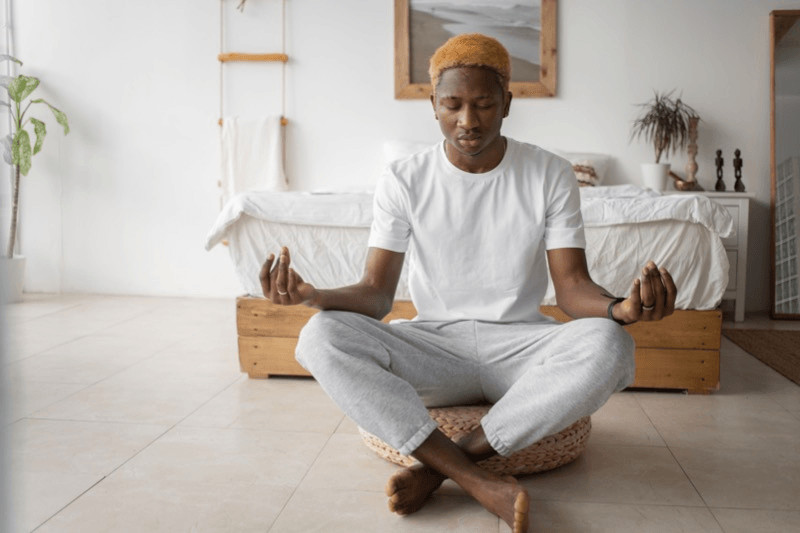
Depending on your level of mobility or specific body proportions, you may benefit from a little extra support while sitting cross-legged. Here are several ways you can utilize props to keep your body comfortable.
- Blanket or cushion: Sit on a folded blanket or small cushion to reduce strain and prevent rounding your lower back. Adding a bit of padding is an easy way to sit longer without discomfort and improves posture.
- Yoga blocks: Reduce strain on your hips by placing yoga blocks under your knees. This reduces the risk of overstretching during long periods of sitting.
- Wall: Sitting with your back against a wall offers extra support for those who need it. It helps keep your body straight with less effort.

lululemon’s Lift and Lengthen Yoga Block
Alternatives to Crossed Legs Position in Yoga
Not everyone benefits from the same seated position. Tailoring your seat to fit your body’s needs is essential for maximum benefit.
Some people find sitting cross-legged comfortable, while others do not, even with the help of props. If you have difficulty finding a comfortable seat, try these alternate positions while stretching, meditating, or breathing exercises.
Accomplished Pose
Also known as Siddhasana, this asana is a slight variation of sitting cross-legged. Instead of crossing one ankle over the other, fold your legs in one at a time so both ankles lay flat on the floor.
This slight alteration can make a big difference in reducing tension in your ankle joints.
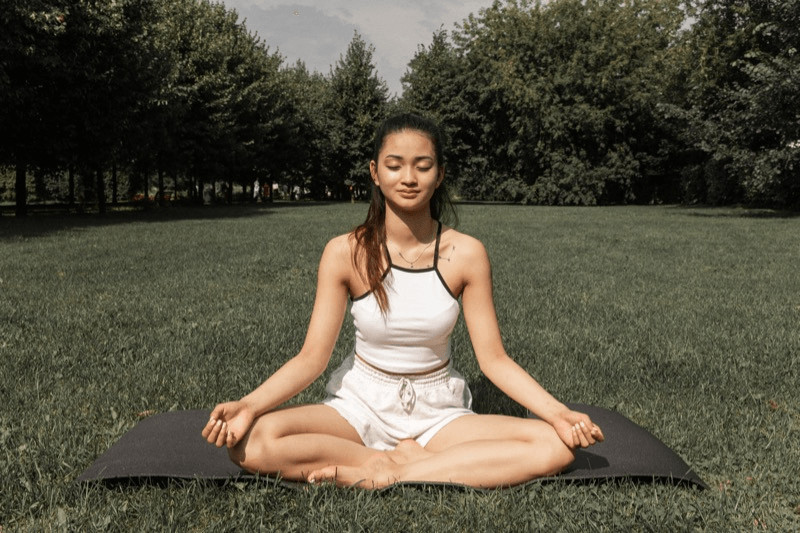
Thunderbolt Pose
Thunderbolt or Vajrasana is a simple kneeling position that may be more comfortable for people lacking flexibility in their hips. Place a cushion or two yoga blocks under your sit bones for more support.
My legs tend to fall asleep when I sit for a meditation or mantra chanting practice that lasts ten minutes or more. I can sit comfortably much longer when I use Vajrasana supported with blocks as an alternate.
Staff Pose
If you have circulation issues when you sit with your knees bent, try keeping your legs straight instead.
Staff Pose or Dandasana does require hamstring flexibility, so be sure to use props if you need extra support. I recommend sitting on a folded blanket to elevate your hips and placing a bolster under your knees.
Sit in a Chair
Using a chair is a wonderful and accessible alternative to sitting cross-legged. It helps keep the spine straight without straining the legs. Be sure you place yourself toward the front of the chair’s seat with your feet firmly planted on the floor.
This position is suitable for people who need better circulation and posture support or those with limited mobility who have difficulty getting to the floor.
Once you find a seat that works for you, sign up for a free trial at Yogaworks.com and explore their meditation and pranayama classes.
Advice for Physically Adapting to Cross-Legged Sitting
If you experience discomfort while sitting cross-legged, don’t get discouraged! Your body might need to get used to the position. Physical therapists believe you can train your body to become more comfortable in this position through regular exercise and stretching.
Creating a comfortable seat in Sukhasana is possible with patience and consistency. As you incorporate this position into your yoga practice, follow these recommendations.
- Adjust duration: Avoid pushing yourself beyond your limits, which might cause muscle strain. Start with short periods or no more than 1 to 2 minutes initially. Then, gradually increase the time as your body adapts.
- Take movement breaks: Even in the middle of a meditation, you must listen to your body and make adjustments when you experience discomfort. I find it helpful to stretch my legs out in front of me for a few breaths or move through a few rounds of seated Cat and Cow stretches.
- Practice regularly: Consistent practice is the best way to become more comfortable in the cross-legged position. If you don’t have time for a complete yoga practice, spend a few minutes in Sukhasana. With time, the position will become more familiar and easy.
Closing Thoughts
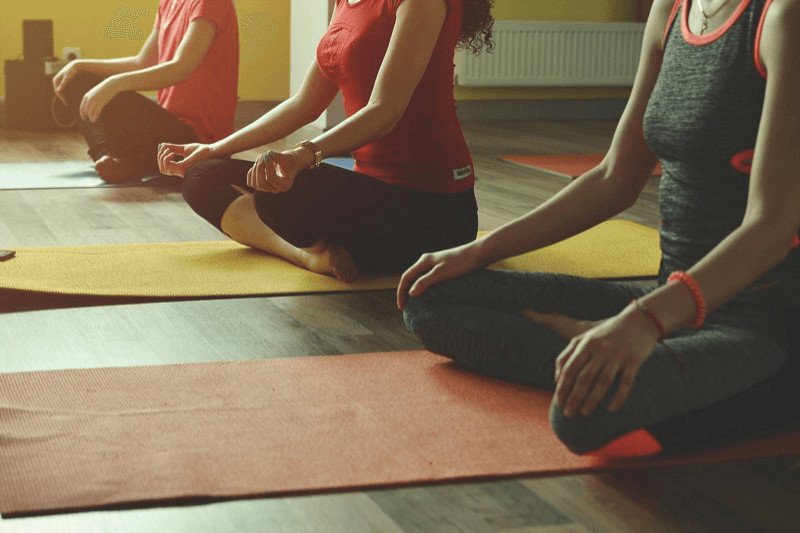
Within the realm of health and wellness, sitting often incites criticism due to our overly sedentary lifestyle. However, practicing with intention and proper alignment isn’t always detrimental to our health.
The ability to sit cross-legged in Sukhasana is a fundamental skill in yoga and meditation practice as a grounding posture when you want to stretch your upper body or calm your mind.
Not everyone finds comfort in this postnaturally ure and may benefit from using props like blankets or blocks. In other cases, it’s worth exploring other sitting positions to discover what feels best in your body.
I encourage adjusting your sitting posture and incorporating daily practice into your routine. Remember, small changes can lead to significant improvements and help you get the most out of your yoga practice while supporting your overall health.
Pop quiz! 🧘🤔
Flexibility does not affect this position at all.
Sitting in a cross-legged position for long periods may affect circulation in your legs.
Sitting cross-legged in Yoga is called Vajrasana.
Frequently Asked Questions
What are some common uses of the cross-legged position?
The cross-legged position is widely used in yoga practices for meditation, breathing exercises (pranayama), and specific asanas. It’s also a preferred seating arrangement during educational sessions or gatherings focused on mindfulness.
What are some common mistakes people make when sitting cross-legged?
Common mistakes that can contribute to discomfort in this position include not stretching beforehand and misaligned posture, such as tilting to one side or leaning to the front or back.
How can I ease discomfort when sitting in a cross-legged position?
To maintain a comfortable seat, try using supportive props like a blanket or cushion under your hips or blocks under your knees. Remember to stretch before you take a seat, and allow yourself some movement breaks when needed.
Are there alternatives to sitting with crossed legs in yoga if it causes discomfort?
Yes, alternative postures include Vajrasana (Thunderbolt), Siddhasana (Accomplished), and Dandasana (Staff) or sitting on a chair with feet flat on the ground for support.


